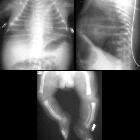campomelic dysplasia


Campomelic dwarfism, also known as campomelic dysplasia, is a rare form of skeletal dysplasia.
Epidemiology
Campomelic dwarfism is rare with an estimated incidence of ~1:200,000 births.
Associations
- genital malformations: may be present in ~66% of patients
Clinical presentation
Diagnosis is usually readily made at birth or with antenatal ultrasound. It is frequently associated a number of non-skeletal abnormalities including:
Pathology
Genetics
It is thought to result from a mutation in a gene located on chromosome 17 which encodes for a transcription factor named Sox9 . There may be an autosomal recessive inheritance .
Radiographic features
Antenatal ultrasound
Findings include:
- lower extremity bowing: femoral/tibial bowing
- reduced chest circumference: narrow fetal thorax
- hypoplastic scapulae
Plain film
Plain films are all that is usually required to confirm the diagnosis.
- chest
- hypoplastic scapulae
- narrow chest - narrow fetal thorax/bell-shaped thorax
- vertebral hypoplasia
- eleven ribs
- limbs
- dislocated hip and knee joints
- bowing of femur and tibia
- hypoplastic fibula
- pelvis
- dysplastic acetabulum and iliac bones
Treatment and prognosis
Campomelic dysplasia is not compatible with long term survival and 97% of patients die within their first year due to respiratory insufficiency.
History and etymology
It is derived from the Greek "campo" (bent) and "melia" (limb).
Siehe auch:
und weiter:

 Assoziationen und Differentialdiagnosen zu camptomelic dysplasia:
Assoziationen und Differentialdiagnosen zu camptomelic dysplasia:


